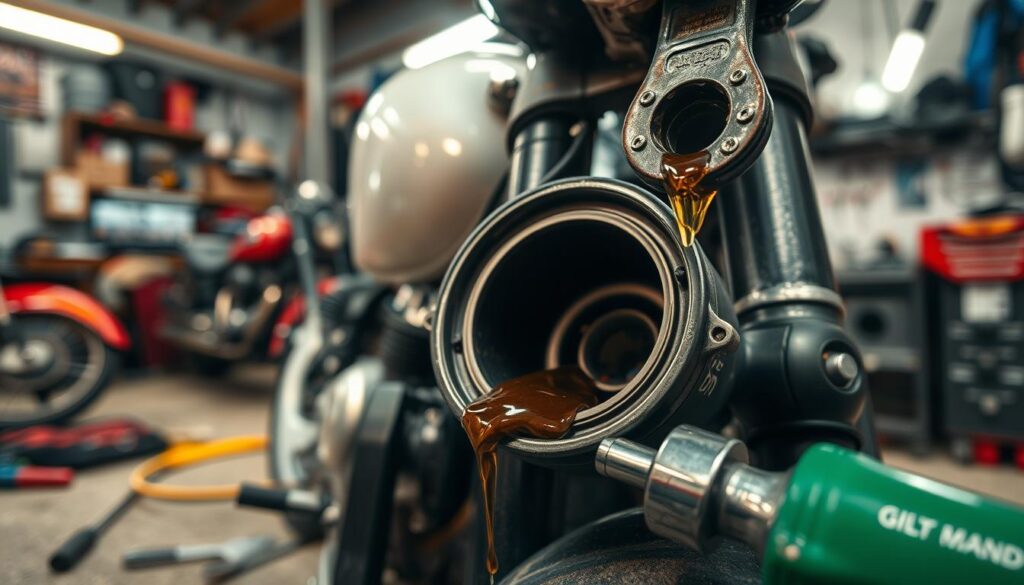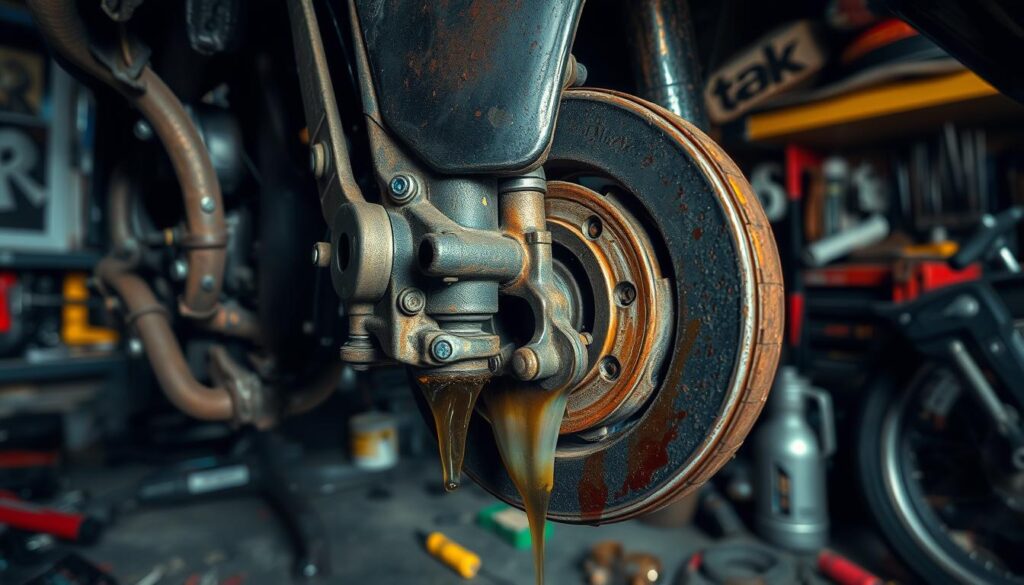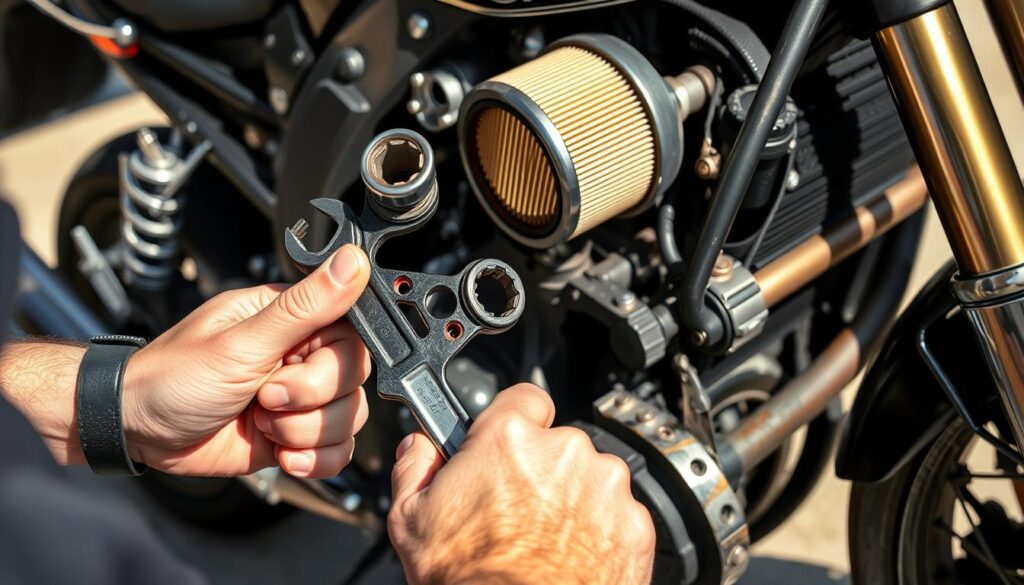I love the thrill of riding my motorcycle through winding roads. The engine’s power feels amazing beneath me. But, neglecting bike maintenance can ruin the fun. Today, I’ll share common mistakes to avoid, so you can enjoy the ride without worries.
In This Guide
Understanding Basic Motorcycle Maintenance Requirements
Keeping your bike in good shape is key to its long life and performance. Ignoring maintenance can cause expensive fixes later. Knowing the basics of bike care is vital.
Essential Maintenance Schedule Components
A good maintenance plan includes several important steps:
- Regular oil and filter changes
- Periodic brake pad inspections and replacements
- Chain lubrication and adjustment
- Tire pressure and tread depth checks
- Air filter replacements
- Battery maintenance and charging
Manufacturer-Recommended Service Intervals
Following your bike’s service schedule is crucial. Your owner’s manual will tell you when to do maintenance tasks. This keeps your bike running smoothly.
Basic Tools Every Rider Needs
Every rider should have some basic tools. These include:
You know how important your tires are to your bike’s performance and safety. With this reliable pressure gauge, you’ll always keep them at the optimal level, ensuring smoother rides and better control. Whether it’s a quick check before a long trip or regular maintenance, this tool simplifies it all for you
When it comes to tightening bolts, precision is everything. With this torque wrench, you’ll have the confidence to secure every part of your motorcycle without overdoing it. Extend the life of your bike while riding with peace of mind, knowing everything is perfectly adjusted.
Your bike’s chain deserves proper care, and this tool makes it effortless. From repairs to adjustments, you’ll find this tool invaluable for keeping your ride smooth and efficient. It’s a must-have for any motorcycle owner serious about maintenance.
Replacing or maintaining spark plugs can feel tricky, but not with this handy wrench. Designed to give you a firm grip and easy access, it simplifies one of the most important aspects of engine care.
Small adjustments can make a big difference in your ride, and this hex key set puts all the power in your hands. Compact, sturdy, and ready for every situation, this is the toolkit every rider like you needs to have.
Whether you’re tightening loose screws or making precision adjustments, this screwdriver set is here to save you time and hassle. Designed for durability and easy handling, it’s an essential addition to your gear.
Knowing the basics and having the right tools helps you care for your bike. This way, you can avoid expensive repairs later.
Neglecting Regular Chain Maintenance and Adjustment
As a motorcycle enthusiast, it’s key to know how important chain maintenance is. Not taking care of it can cause big problems, like poor performance and breakdowns. Sadly, many riders ignore this important task, leading to serious issues.
One big motorcycle tune-up mistake is not lubricating and adjusting the chain right. A dry, stretched chain can damage sprockets and cost a lot to fix. Also, a chain that’s not adjusted well can wear out tires unevenly, making the bike hard to control and unsafe.
- Not lubricating the chain often can make it wear out faster, leading to more friction.
- Adjusting the chain wrong can cause too much slack or tension, damaging other parts of the bike.
- Ignoring bike care omissions like chain maintenance can also hurt the bike’s performance, making it slower.
To avoid these motorcycle neglect issues, follow the maker’s service schedule for chain care. This usually means checking and adjusting the chain every few hundred miles, or as the manual says.
Regular chain care can make your motorcycle last longer, ride better, and be safer. Don’t let ignoring this key part become a big mistake.
Improper Tire Pressure and Tread Management
Keeping your motorcycle’s tires at the right pressure and tread depth is key. It ensures your bike rides safely, performs well, and gets better gas mileage. If you ignore these steps, you might face problems like poor handling, less grip, and even tire blowouts.
First, make sure your tires are inflated to the level the maker suggests. Tires that are too low can make your bike use more gas and wear out faster. On the other hand, tires that are too high can make your ride uncomfortable and less stable.
- Regularly check your tire pressure with a reliable gauge, adjusting as needed.
- Refer to your owner’s manual or the information on the motorcycle’s information placard for the correct tire pressure specifications.
It’s also vital to keep an eye on your tires’ tread depth. Tires with thin tread can’t grip the road well, especially when it’s wet or slippery. This can lead to skidding and accidents. The two-wheeler maintenance pitfalls of ignoring tread depth can be risky and expensive.
| Tread Depth Recommendation | Minimum Acceptable Tread Depth |
|---|---|
| 4/32 inch (3.2 mm) | 2/32 inch (1.6 mm) |
By being careful and fixing motorcycle maintenance failures related to tire pressure and tread, you can keep your bike safe and efficient. This also helps your tires last longer.
“Proper tire maintenance is the foundation of safe and reliable motorcycle riding. Don’t let motorbike servicing errors compromise your enjoyment and security on the road.”
Oil Change Errors and Fluid Level Mistakes
Keeping your motorcycle in top shape is key to its performance and life. Yet, many riders miss out on important care, like oil changes and fluid checks. These motorcycle repair blunders and bike upkeep oversights can cause big problems and even risk your safety.
Correct Oil Selection Guidelines
Picking the right engine oil is crucial. You need to think about viscosity, quality, and if it fits your bike’s engine. Wrong oil can wear down your engine, hurt fuel efficiency, and even damage it over time.
Proper Oil Change Procedures
- Make sure your bike is on a level surface and the engine is warm before you start.
- Find the oil drain plug and have a container ready to catch the old oil.
- Remove the drain plug and let the oil drain completely from the engine.
- Put in a new oil filter and tighten it as the maker says.
- Fill the engine with the right amount and type of new oil.
- Check the oil level and add more if needed, making sure it’s in the right range.
Common Fluid Level Checking Errors
- Forgetting to check coolant, brake, and transmission fluid levels often.
- Putting too much or too little fluid in, causing system problems.
- Not looking at the fluid for signs of dirt or wear.
| Fluid | Recommended Checking Interval | Acceptable Fluid Level Range |
|---|---|---|
| Engine Oil | Every 3,000 miles or as per manufacturer’s guidelines | Between “Min” and “Max” marks on the dipstick |
| Coolant | Every 6 months or 6,000 miles | Between “Min” and “Max” marks on the overflow reservoir |
| Brake Fluid | Every 6 months or 6,000 miles | Between “Min” and “Max” marks on the reservoir |
| Transmission Fluid | As per manufacturer’s recommendations | Between “Min” and “Max” marks on the dipstick |
Knowing how to pick the right oil, change it correctly, and avoid fluid mistakes can save you a lot of trouble. It keeps your bike running well for many years.

Battery Care and Charging System Oversights
Keeping your motorcycle’s battery and charging system in good shape is key. Many riders miss out on these important steps, leading to problems. We’ll look at common motorcycle tune-up mistakes, bike care omissions, and motorcycle neglect issues related to these areas.
Battery Maintenance Matters
The motorcycle battery is vital for starting your bike and powering electronics. If you ignore battery care, it can fail early, leaving you stuck. Always check the battery’s charge, clean the terminals, and replace it when needed. Skipping these steps can cause starting issues and electrical problems.
Charging System Oversights
The charging system keeps your battery charged while riding. If it’s not maintained, the battery will drain, causing starting problems and electrical failures. Regularly check the alternator, voltage regulator, and wiring to ensure your charging system works right. Ignoring these parts can lead to motorcycle neglect issues.
| Common Battery and Charging System Oversights | Potential Consequences |
|---|---|
| Neglecting battery maintenance | Premature battery failure, starting problems |
| Ignoring charging system components | Draining battery, electrical system failures |
| Failing to replace battery and charging system parts | Unreliable performance, increased risk of breakdowns |
By keeping up with your motorcycle’s battery and charging system, you can dodge bike care omissions and motorcycle tune-up mistakes. A well-kept electrical system is essential for a smooth ride.
Brake System Maintenance Blunders
Keeping your motorcycle’s brakes in good shape is key to your safety and fun on the road. Yet, many riders miss out on important brake care. This can lead to motorcycle maintenance failures, motorbike servicing errors, and other two-wheeler maintenance pitfalls. Here, we’ll look at common brake mistakes and give tips to keep your brakes working well.
Brake Pad Inspection Tips
Checking your brake pads regularly is a must. Not doing so can lead to worn-out pads and bad braking. Make sure to check your brake pads every month. Replace them when they’re too thin, as the manufacturer suggests.
Brake Fluid Maintenance
It’s important to keep your brake fluid at the right level and clean. Brake fluid can get damp over time, which can harm your brakes. Always follow your owner’s manual for when to change the brake fluid to avoid two-wheeler maintenance pitfalls.
Common Brake System Issues
If your brakes make strange sounds, feel weird, or don’t work right, it’s a sign of trouble. Problems like worn pads, air in the lines, or bad calipers can all affect your brakes. Fixing these issues quickly can save you money and keep you safe.

| Common Brake System Issues | Possible Causes | Recommended Solutions |
|---|---|---|
| Squeaking or grinding noises | Worn brake pads, contaminated brake pads | Replace brake pads |
| Spongy or soft brake feel | Low brake fluid, air in brake lines | Check and refill brake fluid, bleed brake system |
| Pulling or grabbing brakes | Stuck or seized caliper, uneven pad wear | Service or replace caliper, inspect and replace pads |
By fixing these common motorcycle maintenance failures, motorbike servicing errors, and two-wheeler maintenance pitfalls, you can keep your brakes in great shape. This ensures a safe and enjoyable ride.
Air Filter and Fuel System Negligence
Keeping your motorcycle’s air filter and fuel system in good shape is key. Yet, many riders overlook these important parts. This can cause motorcycle repair blunders and hurt your bike’s performance.
The air filter is crucial for clean air to your engine. A dirty air filter can cut down on power and fuel efficiency. It can even damage your engine. So, it’s important to check and replace the air filter regularly, as the maker suggests.
The fuel system, including the tank, lines, and injectors, also needs care. Problems like clogged injectors or old fuel can cause engine issues. Cleaning and replacing parts as needed keeps your bike running well.
By paying attention to your air filter and fuel system, you can avoid motorcycle repair blunders. This makes for a better, more reliable ride and saves you money in the long run.
“Neglecting your motorcycle’s air filter and fuel system is like trying to run a marathon without proper training – it’s a recipe for disappointment and potential disaster.”
Ignoring Unusual Sounds and Vibrations
Many riders ignore unusual sounds and vibrations from their motorcycles. These signs can warn of mechanical problems that need quick fixes. By listening to your bike, you can catch issues early and avoid expensive repairs.
Common Warning Sounds
Knocking, grinding, or rattling sounds often mean engine or transmission trouble. Paying attention to these noises can help you find and fix the problem. Changes in the exhaust sound or strange hissing can also point to air or fuel system issues.
Vibration Troubleshooting Guide
Vibrations are a big worry, as they might mean worn-out bearings or unbalanced wheels. First, check your tires for uneven wear. If vibrations don’t go away, it’s time to dig deeper. Ignoring vibrations can lead to serious damage.

